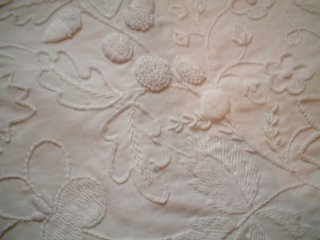
I had been hoping to find a piece of genuine Irish 'Mountmellick' embroidery for some time, and suddenly there it was, right at the bottom of a cardboard box of old linen, bought at auction recently. This was a nightdress case, heavily embroidered with whitework flowers and leaves on a heavy, almost satiny cotton. It even had the characteristic fringed edge, although that had suffered some damage, as had the body of the case, which was missing a corner. It looked a bit as though someone or something had taken a wee bite out of it! But the embroidery itself was mercifully free from faults, and as beautiful as I had hoped it would be, complete with oak leaves, acorns, grapes and passion flowers.
It was, seemingly, the natural plants which grew along the Owenass River which inspired these designs: blackberries, oaks and acorns, roses, woodbine, wild clematis. Passion flowers seems to have been a favourite cultivated plant to be depicted, while butterflies and seashells are sometimes found. The pieces were useful as well as beautiful, and most Mountmellick can be washed, even at high temperatures. In fact you will often find that the more a piece is laundered, the better it looks, with a softness and patina that is hard to fake.
The history of Mountmellick, is part of the wider history of lacemaking in Ireland. One Joanna Carter received an award in 1816 for developing new embroidery stitches and by 1825 she had set up a small school in Mountmellick, County Laois, to teach the skills to the young women of the district. Like many of these industries, it was thought to be a good way of encouraging women to contribute to the economy of the family. In the early 19th century we find a genuine movement to set up schools of needlework and lace in Ireland with Limerick and Carrickmacross Laces, as well as impossibly fine Irish crochet, Irish whitework, and of course, Mountmellick itself.
It fascinates me how much of this obviously Irish embroidery and lace turns up here in the West of Scotland. Sometimes it seems as though every other piece of lovely old linen is decorated with shamrocks, or of obvious Irish provenance, like my piece of Mountmellick. I only wish the textiles could tell me their stories. But somewhere at the back of my mind is a vision of a woman who learned her craft at home in Ireland, but who - like some of my own forebears - crossed the sea, in search of work, a viable way of life, or even an escape from famine. I think about her quite a lot. Was she homesick, here in Scotland? When she stitched the flowers of the Owenass River, so beautifully into her nightdress case, did she still think of that place as home? When she worked those fine white shamrocks into the fine white linen of a small tablecloth, was she thinking of Ireland? Who was she? And above all, why did nobody remember, and keep these precious textiles in the family? It makes me quite sad to think of her, but at least the work of her hands is still loved and appreciated, usually by other women, all these years later.
For more information about Mountmellick embroidery, go to http://islandireland.com
1 comment:
Hi Catherine,
That's a lovely example of Mountmellick embroidery! You are very fortunate to have it.
Yvette Stanton
Author of "Mountmellick Embroidery: Inspired by Nature"
http://www.vettycreations.info
Post a Comment